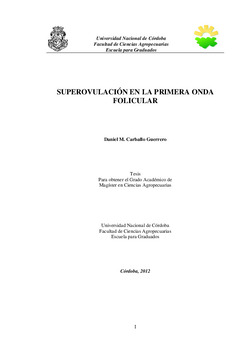| dc.contributor.advisor | Bó, Gabriel Amílcar | |
| dc.contributor.author | Carballo Guerrero, Daniel M. | |
| dc.date.accessioned | 2015-02-09T20:46:24Z | |
| dc.date.available | 2015-02-09T20:46:24Z | |
| dc.date.issued | 2012 | |
| dc.identifier.uri | http://hdl.handle.net/11086/1696 | |
| dc.description | Tesis (Magister en Ciencias Agropecuarias)--UNC- Facultad de Ciencias Agropecuarias, 2012. | es |
| dc.description.abstract | El objetivo de la tesis fue desarrollar un protocolo de superovulación durante la primera onda folicular, sin el uso de estradiol. En el primer experimento se comparó la respuesta superovulatoria de vacas tratadas durante la primera onda folicular con vacas superovuladas 4 días después de la aplicación de estrógenos y progesterona. Las vacas del grupo experimental recibieron un dispositivo intravaginal con progesterona por 10 días, aplicando prostaglandina al día de inserción y de retiro, con el fin de formar un folículo persistente. A las 36 h de la remoción del dispositivo se aplicó GnRH y se inicio la superovulación 36 h después. A las vacas del grupo control se les inicio la superovulación 4 días después de la aplicación de progesterona y estradiol. No hubo diferencias significativas en la respuesta superovulatoria. En el segundo experimento se evaluó el efecto de la duración del pretratamiento con dispositivos liberadores de progesterona. Se concluyó que la reducción del pretratamiento no afectó la respuesta superovulatoria. En el tercer experimento se comparó la respuesta superovulatoria de donantes en las cuales el dispositivo liberador de progesterona fue removido o no previo a la inducción de la ovulación con GnRH. No hubo diferencias significativas en el porcentaje de vacas que ovularon después de la primera GnRH y la respuesta superovulatoria entre los grupos fue similar sin diferir significativamente. El experimento 4 tuvo como objetivo evaluar el efecto de la duración del tratamiento superovulatorio, haciendo un grupo con 5 días (10 aplicaciones cada 12h) y otro con 4 días de FSH (8 aplicaciones cada 12h). No hubo diferencias significativas entre los grupos. En el quinto y último experimento se evaluó si era necesaria la administración de prostaglandina previa a la aplicación de GnRH. Además se volvió a comparar la respuesta del tratamiento de primera onda con GnRH con el tratamiento tradicional con estradiol y progesterona. No se encontraron diferencias significativas entre los grupos. Los resultados obtenidos en los experimentos soportan la hipótesis de que los tratamientos superovulatorios iniciados en la onda folicular desarrollada al momento de la ovulación de un folículo persistente, resultan en una respuesta similar a los iniciados 4 días después de la aplicación de estrógenos y progesterona. | es |
| dc.description.abstract | The objective of the thesis was to develop a protocol for superovulation during the first follicular wave, without the use of estradiol. In the first experiment, we compare the superovulatory response in donor cows treated during the first wave of follicular development with that of cows superovulated 4 days after the application of estradiol and progesterone. Cows from the experimental group received an intravaginal progesterone device for 10 days, using prostaglandin at the day of insertion and removal of the device, to form a persistent follicle. GnRH was administered 36 h after device removal and superovulation was initiated at 36 h after GnRH. Cows in the control group received the superovulation 4 days later received progesterone and estradiol. There were no significant differences in superovulatory response. In the second experiment we evaluated the effect of duration of the pretreatment with progesterone releasing devices on the superovulatory response. It was concluded that the duration of pretreatment can be reduced from 10 to 5 days, without affecting the superovulatory response. In the third experiment we compared the superovulatory response of cows in which the progesterone releasing device was removed prior to the GnRH for induction of ovulation. There were no significant differences in the percentage of cows that ovulated after the first GnRH and superovulatory response was similar without significant differences. Experiment 4 evaluated the effect of duration of the superovulatory treatment, comparing the treatment with FSH for 5 days and the treatment with FSH for 4 days. There were no significant differences between the groups. In the fifth and final experiment we evaluated whether it was necessary or not to administer prostaglandin prior to the application of the first GnRH. Furthermore, we compared again the response to treatment during the first wave with the traditional treatment with estradiol and progesterone. There were no significant differences between groups. The results obtained in experiments support the hypothesis that superovulatory treatments started in the first follicular wave developed at the time of ovulation of a persistent follicle, resulted in a similar response to the superovulatory treatment initiated 4 days after application of estradiol and progesterone. | en |
| dc.format.extent | 66 h. : ilustración color | |
| dc.language.iso | spa | es |
| dc.rights | Atribución-NoComercial-SinDerivadas 2.5 Argentina | * |
| dc.rights.uri | http://creativecommons.org/licenses/by-nc-nd/2.5/ar/ | * |
| dc.subject | Superovulación | es |
| dc.subject | Reproducción animal | es |
| dc.title | Superovulación en la primera onda folicular | es |
| dc.type | masterThesis | es |





